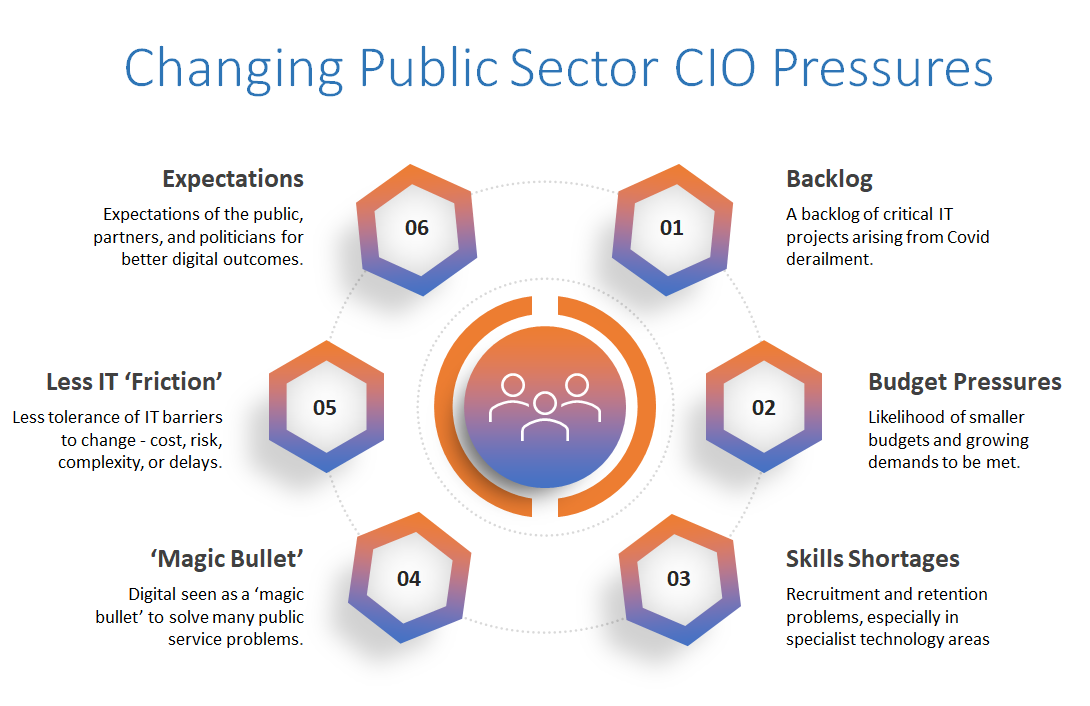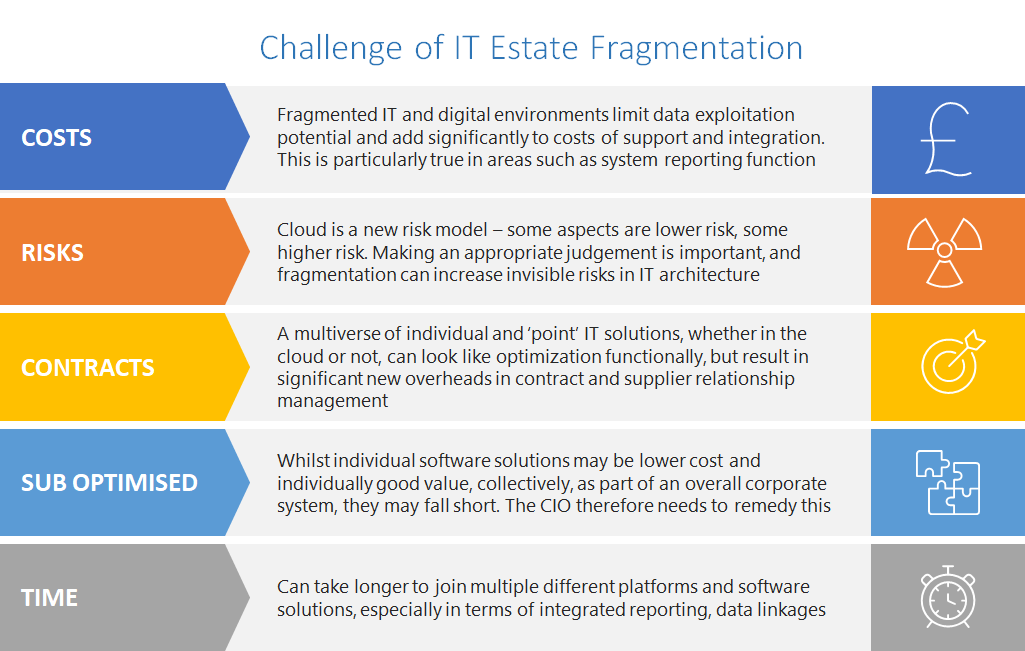How to get the most out of your IT estate by being in control of it.
It’s always a stimulating conversation when you meet a group of experienced public sector leaders, with IT suppliers, for a ‘Chatham House Rules’ debate about delivering the best value from complex IT solutions. This roundtable event, sponsored by Claremont, was no exception.
CIOs and technology experts came from across the public sector, with experience covering local government, housing associations, universities, and police.
Our challenge was to consider how CIOs in the public sector can exploit software platforms such as Oracle E-Business Suite (EBS) whilst managing costs, risks, pressures, and supplier relationships.

The heart of our discussion was about the CIO being in control of the IT agenda - and how and when upgrades and cloud migrations occur, rather than being pushed by software suppliers wanting to move clients to the next ‘big thing’. This included the importance of establishing a way of working with 3rd party IT service partners in 2022 that maximises the value of that relationship.
Oracle E-Business Suite (EBS) is widely used, and whilst the direction of travel for Oracle is to the cloud, many EBS users are not necessarily ready for that switch.
The top concerns are the struggle to secure new value that would offset the cost and risk of change in the current climate. The same, of course, applies to other core business-critical software platforms.
Public sector CIOs are under immense pressure today, more so than in the past. Some of these pressures, as noted by the roundtable participants, include:

Prioritisation is essential if a CIO is to reduce the number of ‘desirable’ but not necessarily ‘business-critical’ projects. For the attendees, the measure was a quantifiable value. That will often mean some things have to wait - so an upgrade or migration to the cloud may need to be deferred in favour of getting more value out of existing tools that are working satisfactorily.
Each of our CIOs described projects focused on better exploiting existing IT estate to buy time and value that created capacity for innovation.
Prioritising the improved exploitation of what you already have, rather than migrating to the ‘next big thing’, is a tricky judgement. Our CIOs described the questions they ask to make that judgement, especially in a complex cloud migration project for Oracle EBS:

All agreed that a public service organisation's IT roadmap should be driven by the CIO, not suppliers forcing change or cloud migration. A measured and planned cloud upgrade in the future might also require rationalisation and updating of the existing estate to reduce the risk and cost of future migration.

The challenge with a sophisticated environment such as Oracle will always be how to take advantage of the potential without taking on costs and risks not justified by the maturity of the public sector organisation. As one CIO said:
There was agreement that initially provided for a minimum viable solution which can be a successful approach to managing change, with benefits realisation being provided for in subsequent updates. This ensures success for critical updates and provides potential benefits in a (change) managed fashion.
There will always be lower ‘total cost of ownership' options on the market if the full value of an integrated ERP suite is not used. Being led by a supplier’s agenda of upgrade paths can often make it harder for public sector CIOs to deliver value for money.
At the same time, our CIOs described the risks involved in allowing IT architecture to fragment into smaller software components and cloud services from different organisations:

The CIOs attending the event described how Oracle is used as a backbone for business areas such as finance, procurement, human resources, payroll, asset management and customer relationship management. But extracting value and containing costs was not always easy. And whilst a ‘cloud first’ model has attractions, it can be a challenging change programme, with various costs and risks to expose.
Our attendees did agree that resisting change was also not the answer. Outdated or unpatched software leads to hidden risks and costs. The IT team needs the capacity and the time to research and implement additional features where there is business justification.
All of the CIOs at the table talked about the need to develop and build internal IT capacity, not just to outsource or rely on third-party suppliers. The CIOs recognised that there are challenges with building, maintaining and developing internal teams within the public sector. The IT jobs market is currently candidate-led, and the public sector is constrained in terms of benefits and salaries that can be offered in a way that private industry is not.
There is a clear need to augment that capacity with external assistance. Building relationships with IT suppliers that can assist with skills transfer and genuinely empathise with the in-house IT team's pressures, challenges, and requirements was a clear priority for everyone. Four areas, in particular, stood out:

The CIOs felt that all parts of the public sector were looking for IT partners with a focus on helping manage change, reduce risks, and offer skills transfer (doing ‘with’ the in-house team, not just ‘for’ the team). This allows a dynamic balancing of in-house and external skills, irrespective of the different IT service models in different public service organisations.
Also, for a public service organisation, outsourcing the whole task to a large systems integrator is a costly and complex option when budgets are inevitably constrained. From a services perspective, it is agreed that having a few overlapping trusted suppliers was the best approach.
There was also a general agreement that the requirements from IT suppliers have changed. In addition to supplying products and services, there is an immense value in sharing best practices and case studies, helping to identify where the value lies and how to realise it. IT suppliers need to be a ‘critical friend’, empathising with the business pressures, needs and priorities of the client whilst helping to identify where real digital opportunities exist. There was agreement that having a single point of contact within a supplier helps ensure the relationship's success.
There was general agreement that procurement within the public sector is often hard work. The public and private sector representatives at the round table agreed that it could sometimes compromise innovation, add to costs, take too long, and constrain relationship building because of the formality.
Whilst the processes are there to protect the public purse and to ensure equal opportunity for suppliers, in software procurement, it can be hard to specify every aspect of a complex development programme in advance. It was agreed that, certainly, for larger engagements, the requirement will always change to some degree.

In an ideal world, greater latitude and flexibility are needed. The roundtable participants felt that public sector procurement teams must work differently to achieve this – accepting ‘more flexible arrangements. It is a mistake to think that the tighter a contract, the better the value or lower the risk.
Social value is now a big part of public sector procurement measures, especially in central government, where it accounts for 10% of the total value. The consensus of the debate was that social value could be a genuine opportunity rather than a tick-box exercise. It, however, depends on the context: the organisation type and culture, the service being bought, and even the location. It is easier to see how social value can work for a local council than for a government department.

Advice for CIOs approaching a significant upgrade or cloud migration was to “make as little noise as possible”. In other words, to demonstrate and deliver value, but neither make a ‘song or dance’ about it nor create organisational ripples because of problems and service outages. Managing service expectations and keeping a ‘strong hand on the tiller’ is essential.
There is a crucial role here for IT suppliers in helping to support the optimisation of technologies in the context of a public service organisation, not just selling upgrades and new software products.
To exploit an investment in Oracle EBS, public sector CIOs need to ensure that they are in command of the IT road plan. This includes when and how an upgrade takes place in the interest of securing better value, needed functionality, or risk mitigation. They want suppliers who can help them with these as true partners, from design through to implementation, empathising with organisational pressures, internal priorities, politics, and resource constraints.

Jos Creese is an independent digital consultant, researcher, and analyst. He is a strategic advisor to many businesses and government agencies, helping SMEs, particularly, position their products and services to be of the greatest value to the public sector. Since founding CCL in 2015, after 30 years as a public sector CIO, he has helped over 250 public and private organisations on their digital journey.
www.creeseconsulting.co.uk
If you are looking for an Oracle Partner who can help you with your Oracle EBS System, goes about it the right way, and can back up the talk, then contact us.
And if you would like to find out more about NFS Mount Points or have a question, you can email us at info@claremont.co.uk or phone us on +44 (0) 1483 549004.